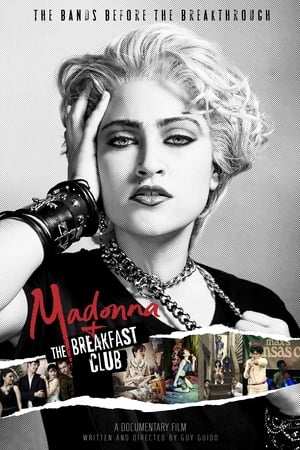
Madonna and the Breakfast Club
Madonna and the Breakfast Club is ostensibly a documentary about Madonna's days as a starving artist in New York with her first band, the titular. However, it plays out more like a kind of patriarchal retrospective revenge/twisted psychosexual fantasy — it certainly gives new meaning to the Madonna-Prostitute complex. The interviewees, all of the male persuasion, paint a portrait in which the singer alternates between an "adorable" little animal (specifically a squirrel or a "baby bird") "writing her little songs," and a sneaky sexual predator who needs to be constantly surrounded by men (other than the narrator, there is only, and briefly at that, one other woman in the film; apparently Madonna didn’t have any female friends) vying for her attention — to the point that she literally pits brother against brother. Dan Gilroy, former Breakfast Club vocalist, comes off particularly badly; much of the footage that appears in the film takes the form of photos and clips recorded by Gilroy while he and Madonna were romantically involved — this has the unfortunate effect of making it seem as if, eons later, he still hasn't gotten over her (and I doubt that has done wonders for the rest of his love life; no woman likes you to keep mementos of an ex, much less if the ex happens to be Madonna). The content of these recordings is so bland — preserving for posterity such inane questions as “why are rats ugly and mice not?” — that the only possible reason for Gilroy to have saved it all this time is so he could play her voice over and over again during those dark, cold nights. It’s writer/director Guy Guido, though, the one with a really unhealthy obsession with Madonna. In 1978 she posed nude for a photographer because she needed money; Guido recreates these sessions, and even produces the guy who took the pictures, who assures us that “My pictures were very statuesque, there was nothing sexual about them” — be that as it may, what does have everything to do with sex is how Guido fetishizes the actress playing the young Madonna (Jamie Auld), who is reduced to prop status — something like Elaine's mannequin in that episode of Seinfeld. What possible reason could there be for recreating photos that, having been published in Penthouse and Playboy, have already been widely circulated? (and it's not because this is one of those documentaries that goes crazy with the reenactments; you know, the kind that accompanies such narration as "She was ready to go. She was ready to move on. She wanted to go to New York" with stock footage of a plane mid-flight). The answer is, for the same reason the film exists in the first place: embarrassing and ridiculing Madonna in any way possible. The movie goes as far, or rather sinks as low, as putting not just words in her mouth, but thoughts in the singer's head. According to the voice-over, “Madonna, as a teenager, entered ballet school. The teacher, Christopher Flynn … guided her and taught her about art and culture outside of suburban Michigan. He also convinced her that she was special and beautiful, words she wasn't used to and words she needed to hear." How exactly does Guido know that Madonna wasn't used to these words, or that she needed to hear them? He doesn't, of course, but the implication is that Madonna had self-esteem issues and didn't consider herself beautiful or special — a claim no one is going to refute because obviously Madonna wouldn't be caught dead appearing in this waste of celluloid. All things considered, the message seems to be "I'm just a footnote in Madonna's career, but at least I slept with her", or "Madonna didn't want to appear in my documentary, but it doesn't matter because I have my own Barbie Madonna that I can undress whenever I feel like it.” Pathetic.
